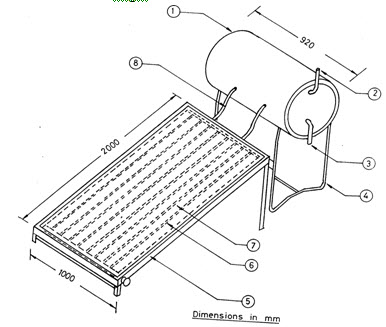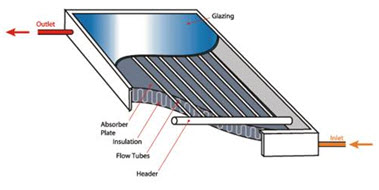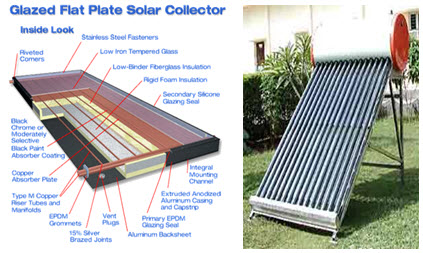Site pages
Current course
Participants
General
MODULE 1. Overview of renewable energy sources
MODULE 2. Characterization of Biomass
MODULE 3. Thermochemical conversion Technology (TCCT)
MODULE 4. Biochemical conversion Technology-Biogas...
MODULE 5. Bio-fuels (BCCT)
MODULE 6. Solar Energy Conversion System (SECS)
MODULE 7. Hydro-Energy Conversion System (HECS)
MODULE 8. Wind Energy Conversion System (WECS)
MODULE 9. Ocean Energy Conversion System (OECS)
MODULE 10. Energy conservation in agriculture
LESSON 25. Solar Water Heater
Solar energy has several advantages over the other energy sources. It is inexhaustible, it is free from any pollution and unlike fossil fuels, transformation of solar energy does not produce any toxic by-products. No nation can put an embargo on its supply. So, if a means could be found to make efficient use of solar energy, it would mean a continuing free supply of energy which would not degrade our environment and also reduce our dependence on non-renewable sources of energy.
The estimated solar energy potential in the country is 200 MW/sq.km and can be utilized both for thermal and electrical applications. The solar thermal applications include hot water systems for industrial, commercial and domestic use besides solar cookers, solar dryers, solar stills and solar photovoltaic cell operated applications aimed at producing power.
Solar Energy Availability in India
Total area of land in India = 3.28 x 1011 m2
Total number of sun shine days in a year = 300 (assumed)
Average solar isolation in India = 500 W / m2
No. of sunshine hours in a day = 5 hours
Total solar radiation received in a day = 3.28 x 10'' x 500 x 5 x 3600 J
= 2.952 x 1015J
= 2.952 x 109 MJ / day
Total solar isolation received in a year in India = 2.952 x 109 x 300
= 8.856 x 10'' MJ
If 1% of land area is used to harness solar energy with thermal efficiency of 10%
Solar energy available for use in a year = 8.856 x 10'' x 0.01 x 0.1
Solar energy available for use in India = 8.856 x 108 MJ
Solar Thermal Devices
The solar water heater consists of a solar collector, insulated stainless steel tank and piping connections. The total system can be mounted on the roof top, on one side the piping connects it to the overhead tank and on the other side to the usage points. The smallest capacity available is 100 litres per day at 600 C temperature, suitable for a family of 4-6 members.
Solar water heater
The solar water heating systems come with a solar collector of 25 sq. m area for solar tank of 100 litre capacity. It occupies an area of 35 sq. ft on the roof top. The water is loaded in the daytime and is stored in the storage tank for a period of 48 hours. This system can be connected to bathrooms and kitchen. Generally, the life of the system is about 15 years and it requires no maintenance.
The collector is having 20 gauge G.I. corrugated sheet as absorber with 12 mm. G.I. pipes as heat exchanger laid in the corrugations of the sheet in serpent fashion. The absorber and the pipes are painted black and embedded in a wooden box insulated at the bottom and sides. The ends of the pipe are connected to the insulated storage drum which is kept just above the collector. The collector is kept on an angle iron stand such that the flat plate is at 11° slope facing south.Hot water temperature is 55 - 63° C on a typical sunny day and heat loss due to over night storage is about 4 to 8°C.

Fig : solar water heater.
1. Insulated water tank 2. Water inlet
3. Water outlet 4. Tank support
5. Frame 6. Liquid pipe
7. Absorber 8. Water line
A solar collector is a device designed to absorb incident solar radiation and to transfer the energy to a fluid passing in contact with it. Utilization of solar energy requires solar collectors. There are two general types - the flat-plate collector and the concentrating (focusing) collector.
Solar collectors may be classified according to their collecting characteristics, the way in which they are mounted and the type of transfer fluid they employ.
(1) Collecting characteristics: A non-concentrating or ‘flat-plate’ collector is one in which the absorbing surface for solar radiation is essentially flat with no means for concentrating the incoming solar radiation. A concentrating or ‘focusing’ collector is one, which usually contains reflectors or employs other optical means to concentrate the energy falling on the aperture on to a heat exchanger of surface area smaller than the aperture.
(2) Mounting: A collector can be mounted to remain stationary, be adjustable as to tilt angle (measured from the horizontal) to follow the change in solar declination or be designed to track the sun. Employing either an equatorial mounting or an altazimuth mounting, for the purpose of increasing the absorption of the daily solar irradiation does tracking.
(3) Types of fluid: A collector will usually use either a liquid or a gas as the transfer fluid. The most common liquids are water or a water-ethylene glycol solution. The most common gas is air.
General Description of Flat-plate Collectors
Flat-plate solar collectors may be divided into two main classifications based on the type of heat transfer fluid used.

Fig 2. Flate plate collector
Liquid heating collectors are used for heating water and non-freezing aqueous solutions and occasionally for non-aqueous heat transfer fluids. Air or gas heating collectors are employed as solar air heaters.
The principal difference between the two types is the design of the passages for the heat transfer fluid.
The majority of the flat-plate collectors have five main components as follows:
(i) A transparent cover which may be one or more sheets of glass or radiation transmitting plastic film or sheet.
(ii) Tubes, fins, passages or channels are integral with the collector absorber plate or connected to it, which carry the water, air or other fluid.
(iii) The absorber plate, normally metallic or with a black surface, although a wide variety of other materials can be used, particularly with air heaters.
(iv) Insulation, which should be provided at the back and sides to minimize the heat losses.
(v) The casting or container, which encloses the other components and protects them from the weather.
A Typical Liquid Collector
Fig.3 is a schematic representation of a typical flat-plate solar collector (plate and tube type). It basically consists of a flat surface with high absorptivity for solar radiation, called the absorbing surface. Typically a metal plate, usually of copper, steel or aluminum material with tubing of copper in thermal contact with the plates, is the most commonly used material. The absorber plate is usually made from a metal sheet 1 to 2mm in thickness, while the tubes, which are also of metal, range in diameter from 1 to 1.5 cm. They are soldered, brazed or clamped to the bottom (in some cases, to the top) of the absorber plate with the pitch ranging from 5 to 15cm. In some designs, the tubes are also in line and integral with the absorber plate. For the absorber plate, corrugated galvanized sheet is a material widely available throughout the world

Fig.3 .Flat Plate liquid collector